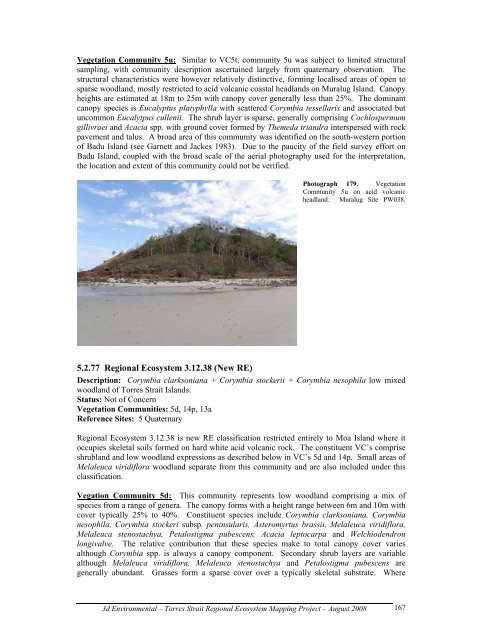Appendix 2 - Vegetation Communities and Regional Ecosystems
Appendix 2 - Vegetation Communities and Regional Ecosystems
Appendix 2 - Vegetation Communities and Regional Ecosystems
You also want an ePaper? Increase the reach of your titles
YUMPU automatically turns print PDFs into web optimized ePapers that Google loves.
<strong>Vegetation</strong> Community 5u: Similar to VC5t, community 5u was subject to limited structural<br />
sampling, with community description ascertained largely from quaternary observation. The<br />
structural characteristics were however relatively distinctive, forming localised areas of open to<br />
sparse woodl<strong>and</strong>, mostly restricted to acid volcanic coastal headl<strong>and</strong>s on Muralug Isl<strong>and</strong>. Canopy<br />
heights are estimated at 18m to 25m with canopy cover generally less than 25%. The dominant<br />
canopy species is Eucalyptus platyphylla with scattered Corymbia tessellaris <strong>and</strong> associated but<br />
uncommon Eucalytpus cullenii. The shrub layer is sparse, generally comprising Cochlospermum<br />
gillivraei <strong>and</strong> Acacia spp. with ground cover formed by Themeda tri<strong>and</strong>ra interspersed with rock<br />
pavement <strong>and</strong> talus. A broad area of this community was identified on the south-western portion<br />
of Badu Isl<strong>and</strong> (see Garnett <strong>and</strong> Jackes 1983). Due to the paucity of the field survey effort on<br />
Badu Isl<strong>and</strong>, coupled with the broad scale of the aerial photography used for the interpretation,<br />
the location <strong>and</strong> extent of this community could not be verified.<br />
Photograph 179. <strong>Vegetation</strong><br />
Community 5u on acid volcanic<br />
headl<strong>and</strong>. Muralug Site PW038.<br />
5.2.77 <strong>Regional</strong> Ecosystem 3.12.38 (New RE)<br />
Description: Corymbia clarksoniana + Corymbia stockerii + Corymbia nesophila low mixed<br />
woodl<strong>and</strong> of Torres Strait Isl<strong>and</strong>s.<br />
Status: Not of Concern<br />
<strong>Vegetation</strong> <strong>Communities</strong>: 5d, 14p, 13a<br />
Reference Sites: 5 Quaternary<br />
<strong>Regional</strong> Ecosystem 3.12.38 is new RE classification restricted entirely to Moa Isl<strong>and</strong> where it<br />
occupies skeletal soils formed on hard white acid volcanic rock. The constituent VC’s comprise<br />
shrubl<strong>and</strong> <strong>and</strong> low woodl<strong>and</strong> expressions as described below in VC’s 5d <strong>and</strong> 14p. Small areas of<br />
Melaleuca viridiflora woodl<strong>and</strong> separate from this community <strong>and</strong> are also included under this<br />
classification.<br />
Vegation Community 5d: This community represents low woodl<strong>and</strong> comprising a mix of<br />
species from a range of genera. The canopy forms with a height range between 6m <strong>and</strong> 10m with<br />
cover typically 25% to 40%. Constituent species include Corymbia clarksoniana, Corymbia<br />
nesophila, Corymbia stockeri subsp. peninsularis, Asteromyrtus brassii, Melaleuca viridiflora,<br />
Melaleuca stenostachya, Petalostigma pubescens, Acacia leptocarpa <strong>and</strong> Welchiodendron<br />
longivalve. The relative contribution that these species make to total canopy cover varies<br />
although Corymbia spp. is always a canopy component. Secondary shrub layers are variable<br />
although Melaleuca viridiflora, Melaleuca stenostachya <strong>and</strong> Petalostigma pubescens are<br />
generally abundant. Grasses form a sparse cover over a typically skeletal substrate. Where<br />
3d Environmental – Torres Strait <strong>Regional</strong> Ecosystem Mapping Project – August 2008<br />
167


